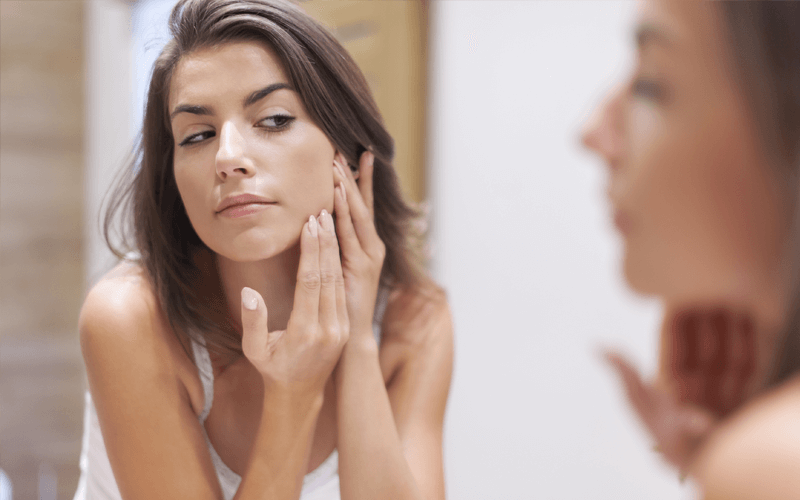Almost everyone has had to deal with a white head at some point, and we all hate those little white/yellowish bumps. What causes those embarrassing blemishes? How can you keep from getting them? What should you do once you have one? Knowledge is power, and we have answers.
What Is a Whitehead?
Whiteheads (also known as closed comedones) happen when oil, dead skin cells, and bacteria become trapped in a hair follicle or pore. That gunk builds up and forms a soft plug inside the pore. If exposed to air, that plug becomes a blackhead. If covered by skin, it becomes a white head.
These annoying clogged pores usually measure between 1 and 3mm across and can appear anywhere on your body. Because they are the result of excess oil and skin cells, you will find them most often where you have the most sebaceous (oil) glands — that is to say, your back, shoulders, neck, and face… particularly in the T-zone of the nose, chin, and forehead.
They affect people of all ages, both men and women. Fortunately, they are considered fairly easy to treat.
What Causes Whiteheads?
We’ve gone over the basics: Dead skin cells, oil, and bacteria become trapped in a follicle or pore. But what else contributes to whiteheads?
Hormonal changes during certain life stages and events can cause your body to increase oil production. More oil means more chances for oil to get trapped in pores. That’s why people tend to get more whiteheads — and acne in general — during puberty, menstruation, pregnancy, and menopause.
Certain medications can also contribute to worsening acne. Ask your dermatologist if any prescriptions you are taking could factor into your skin problems. Genetics also play a considerable role in determining whether you’ll have whiteheads and other acne.
Although many people will tell you to avoid greasy foods to improve your acne, the truth is that those foods do not directly contribute to your whiteheads. There are some actions you can take to reduce your odds of facing these unsightly bumps, though.
How Can I Prevent Whiteheads?
There’s no one thing you can do to guarantee you’ll never encounter another pimple, but there are a few actions you can take to reduce the number of whiteheads you’ll have to deal with:
- Use cosmetics with “noncomedogenic” labels. This means they are specially formulated not to block pores.
- Always remove your makeup before sleeping — even if it is noncomedogenic.
- Use oil-free moisturizers. The last thing you want is whiteheads to add more oil to your face.
- Wash your skin… but not too much. Use a mild cleanser to wash once or twice a day. Any more than that can irritate the skin and might even make things worse. You risk stripping your skin of its natural oils, making your body feel it needs to increase oil production.
- Wash your hair regularly. Oily hair that touches your face can contribute to breakouts. If you have long hair and can’t wash it before sleeping, pull it back away from your face for the night.
- Change your pillowcase regularly. Dirt, oil, and bacteria from your hair and face can build up on your pillowcase, leading to breakouts.
- Don’t pick at them. You’ve heard this advice a million times, but it can be tough to resist when you have an important event and an unsightly bump in the middle of your face. Squeezing whiteheads can irritate or damage skin, possibly even leading to infections, scarring or dark spots. Absolutely not worth it.
- Consult a certified dermatologist. They can help you come up with the best treatment plan for you.
What Are the Treatment Options?
There are a number of over-the-counter ointments, washes, and treatments available. Those that contain benzoyl peroxide reduce oil while those containing salicylic acid attack white heads you already have.
If over-the-counter treatments aren’t doing the trick, it’s time to turn to a skin specialist. Make an appointment with a board-certified dermatologist. They may prescribe topical or oral medications to treat your acne, or antibiotics to reduce inflammation. Options may also include chemical peels, laser therapy, extraction and lifestyle changes.
Your dermatologist can tailor a medical treatment plan to reduce the number of whiteheads you’ll get, to treat those that you already have and to improve scarring or skin damage from previous outbreaks.
Looking to Visit a Dermatologist for Whitehead Treatments?
If whiteheads are getting in your way, U.S. Dermatology Partners can help. We have multiple locations throughout the country, so fill out our simple online form to get in touch with us. One of our local team members will reach out to you shortly to answer your questions or schedule an appointment for you to visit us soon. Your skin and self-esteem will thank you for it.
Find a location near me
or

